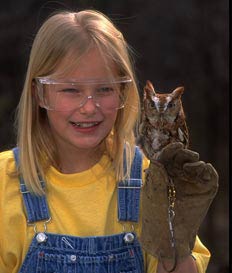Early in the evening as I walked up to my parent's house, I heard what seemed like a very familiar sound. It took me a few minutes, but I finally realized what it was. I walked into the house and announced proudly that there was a screech owl in the maple tree in the backyard. My father looked at my mother and said "I told you so," ever so politely.
This may not seem strange, but my parents live in the middle of town, so this was pretty exciting. I had only been an interpreter for a short time, so it was fascinating to me. I found myself on a quest to learn more about screech owls and their habitat.
The screech owl is very common and widespread, and it is not unusual to find this nocturnal bird in towns and cities. Streetlights attract insects, a food source for these owls. They also enjoy eating mice and small birds, which are found just as easily in the city as in the woodlands. Many homeowners welcome these birds with open arms. They love the fact that they are efficient mousetraps.
Just as with my family, most homeowners recognize the screech owl by its call. This bird is sometimes called a "ghost horse" because of the thin, high-pitched, downward trilling "whinny" it can make. The screech owl also makes a sound that is a continuous high-pitched trill.
Screech owls, like other owls, leave behind traces that they have been there. They do this not only through typical droppings but by leaving owl "pellets." These pellets, which can be found under trees where the birds have roosted, are made up of the non-digestible parts of the food that they eat. After a bird has eaten and begun digestion, the fur and bones are coughed up in a pelletized form. Dissecting one of these pellets is a fun way to discover what the owl has been eating (be sure and wear plastic gloves!)
